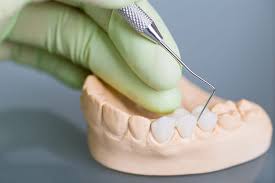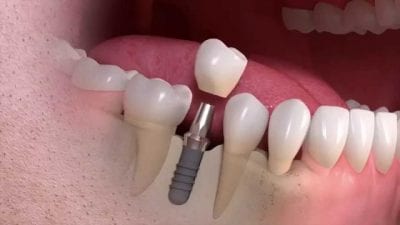Health
Understanding Fillings, Crowns, And Other Restorative Procedures

If you’ve ever wondered about fillings, crowns, and other restorative procedures, you’re not alone. Dental health can seem confusing, but understanding these treatments can help you care for your teeth better. A West Houston dentist can assist you in maintaining a healthy smile. Fillings fix cavities by sealing small holes in your teeth. Crowns cover damaged or decayed teeth, restoring their strength. Meanwhile, other procedures can help with different dental issues. Your oral health is important. It affects your overall well-being. Knowing what to expect can ease any anxiety you might feel about dental visits. Restorative procedures repair and protect your teeth. They aim to keep your mouth healthy for the long term. Rest assured, your dentist is there to guide you through each step, ensuring your comfort and understanding. Taking care of your teeth now means fewer issues later. So, let’s explore these procedures with confidence.
Fillings: A Basic Repair
Fillings are the most common restorative procedure. They are essential for fixing cavities, which occur when tooth decay creates small holes in the teeth. Your dentist will remove the decayed part of the tooth before filling the space with a suitable material. Common materials include amalgam, composite resins, and glass ionomer. The choice depends on the cavity’s location, size, and your personal preference.
The Centers for Disease Control and Prevention (CDC) provides guidelines to help prevent cavities, which can reduce the need for fillings. Practicing good oral hygiene is key to avoiding tooth decay.
Crowns: Restoring Strength
Crowns are used when a tooth is severely damaged or decayed. They act as a cap that fits over the existing tooth, restoring its shape, size, and function. Crowns can be made from materials like porcelain, metal, or resin. Choosing the right material involves considering factors such as durability, esthetics, and cost.
Crowns can help prevent further damage by protecting the tooth underneath. They are also used after root canals to provide extra support. Your dentist will prepare the tooth, take an impression, and create a custom crown that fits perfectly.
Other Restorative Procedures
In addition to fillings and crowns, several other restorative procedures may be necessary to maintain dental health:
- Bridges: These are used to replace missing teeth, filling gaps and preventing misalignment.
- Dental Implants: These are artificial roots placed in the jaw to support a replacement tooth or bridge.
- Inlays and Onlays: These are used to restore teeth with moderate decay or damage that is too extensive for a filling but not severe enough for a crown.
Comparison of Restorative Procedures
| Procedure | Purpose | Materials | Longevity |
|---|---|---|---|
| Fillings | Repair cavities | Amalgam, Composite, Glass Ionomer | 5-15 years |
| Crowns | Strengthen damaged teeth | Porcelain, Metal, Resin | 10-15 years |
| Bridges | Replace missing teeth | Porcelain, Metal, Combination | 5-15 years |
| Implants | Support replacement teeth | Titanium, Zirconia | 20+ years |
Your Role in Oral Health
Your role in maintaining oral health is crucial. Regular dental visits help monitor your oral health and catch problems early. Dentists recommend brushing twice a day, flossing daily, and using mouthwash to remove remaining food particles. Diet also plays a significant role in oral health. Limiting sugary snacks and drinks can prevent cavities.
The National Institutes of Health (NIH) emphasizes the importance of a balanced diet and regular care to prevent dental issues. Combining these practices with professional dental care keeps your teeth healthy and strong.
Conclusion
Understanding fillings, crowns, and other restorative procedures is part of taking charge of your dental health. These treatments protect and repair your teeth, ensuring long-term oral well-being. A West Houston dentist can guide you through the options suited to your needs. Remember, a healthy mouth contributes to a happier life. Follow good oral hygiene practices and stay informed about your dental health. Your smile deserves the best care.
Health
How Periodontal Maintenance Protects Your Investment In Implants

You invested in dental implants to improve your smile and health. To protect this investment, periodontal maintenance is key. Without it, your risk of losing implants increases significantly. dental extractions Westchester County NY could become a necessity without proper care. Regular maintenance checks help you catch issues early, allowing for timely intervention. This preventive care involves more than just brushing. It includes professional cleaning and monitoring by dental experts. They remove hidden plaque and bacteria that brushing misses. This process preserves the health of your gums and implants. You get the peace of mind knowing your implants are protected. Maintaining your gums supports the longevity of your implants. Consider these appointments a necessary part of your routine. Just as you protect your home or car, you must safeguard your dental investments. With consistent periodontal care, you reduce the risk of costly procedures and enjoy a healthier smile.
Understanding Periodontal Maintenance
Periodontal maintenance is a specialized cleaning process. It focuses on preventing inflammation and infection around your implants. During these sessions, dental professionals clean the pockets around your implants. This removes plaque and tartar. Regular cleanings allow your dental team to spot problems early. You gain the chance to address potential issues before they escalate.
Why Your Implants Depend on Healthy Gums
Healthy gums are vital for implant success. Gums provide the necessary support for your implants. When gum health declines, the stability of your implants can be compromised. A strong foundation is crucial. Regular periodontal care ensures your gums stay healthy. Healthy gums are less likely to attract bacteria and plaque. This reduces the risk of infections that could threaten your implants.
The Risks of Neglecting Periodontal Maintenance
Skipping periodontal care could lead to serious consequences for your implants. Without it, plaque and bacteria accumulate. This can cause inflammation and infections. These conditions often result in gum disease. As gum disease progresses, it can lead to bone loss. With bone loss, the implant suffers from reduced support. Ultimately, this can result in the failure of the implant.
Comparing Periodontal Maintenance and Standard Cleaning
| Aspect | Standard Cleaning | Periodontal Maintenance |
|---|---|---|
| Focus Area | Teeth surfaces | Teeth and gum pockets |
| Frequency | Twice a year | Every 3 to 4 months |
| Purpose | General plaque removal | Prevent gum disease |
Benefits of Regular Periodontal Care
Regular periodontal maintenance offers several benefits. First, it promotes overall oral health by keeping infections at bay. Second, it supports the stability and lifespan of your implants. Third, it reduces the need for more invasive procedures later. Finally, it provides a proactive approach to dental health. Given the investment in implants, routine care is a wise choice.
How to Incorporate Periodontal Maintenance into Your Routine
Penciling in periodontal maintenance appointments is crucial. Regular visits, usually every 3 to 4 months, ensure early detection of any issues. Discuss your maintenance plan with your dental professional. They will tailor a schedule based on your specific needs. During these visits, ask questions about your home care routine. Your dental team can provide guidance on brushing and flossing techniques that protect your gums and implants.
Conclusion
Taking care of your dental implants is an ongoing process. Periodontal maintenance plays a fundamental role in safeguarding your investment. By scheduling these regular appointments, you protect your smile and health. You avoid the need for more extensive procedures by catching problems early. Make periodontal maintenance a priority in your dental care routine. You will enjoy the results of a confident, healthy smile for years to come.
For more information, visit trusted sources like the National Institute of Dental and Craniofacial Research or consult with a professional at the Centers for Disease Control and Prevention Oral Health page.
Health
5 Preventive Services General Dentists Recommend At Every Age

Keeping your teeth healthy at any age is essential. A dentist in Georgetown Texas will always emphasize the importance of preventive care. Addressing potential issues before they worsen saves you both pain and cost in the long run. Dentists offer specific services tailored to your age, ensuring the best protection for your teeth. Regular cleanings remove harmful plaque and tartar, preventing decay and gum disease. Fluoride treatments strengthen enamel and guard against cavities. Sealants, especially for children, provide a barrier against bacteria. X-rays detect hidden problems early, allowing for timely interventions. Finally, regular oral cancer screenings give peace of mind and promote early detection. By following these recommendations, you safeguard your smile for years to come. Trust in these preventive measures and prioritize your oral health. Your dentist knows what’s best for your teeth now and in the future. Protect your smile with these essential services.
1. Regular Cleanings
Regular dental cleanings are the cornerstone of oral health. They remove plaque and tartar, which can lead to cavities and gum disease. Plaque is a sticky film of bacteria that constantly forms on your teeth. When it hardens, it becomes tartar. Only professional cleaning can remove it. Cleanings help prevent tooth decay and gum disease, which can lead to tooth loss. The American Dental Association recommends visiting your dentist twice a year for cleanings. These appointments not only keep your teeth clean but also allow your dentist to catch potential problems early.
2. Fluoride Treatments
Fluoride treatments are another preventive measure dentists recommend. Fluoride is a mineral that strengthens tooth enamel and prevents decay. It provides an extra layer of protection against the acids that cause cavities. Dentists apply a concentrated fluoride solution during routine visits. This treatment is especially important for children, but adults benefit too. The Centers for Disease Control and Prevention highlights the effectiveness of fluoride in reducing tooth decay. Fluoride treatments are quick and painless but offer lasting benefits.
3. Dental Sealants
Dental sealants are thin protective coatings applied to the chewing surfaces of back teeth. They act as barriers, preventing food and bacteria from getting stuck in the grooves and pits of the teeth. This is particularly beneficial for children and teenagers, who are more prone to cavities. Sealants are a safe and painless way to protect teeth. They are effective for up to ten years, offering long-term protection. The CDC notes the importance of sealants in preventing cavities in children.
4. X-rays
X-rays are vital for detecting dental issues not visible to the naked eye. They reveal cavities between teeth, infections in the bone, and even tumors. Regular X-rays help your dentist catch problems early, allowing for less invasive treatment. Your dentist will schedule X-rays based on your age, risk factors, and symptoms. The frequency varies, but they are an essential tool for maintaining oral health. X-rays are safe and involve minimal radiation exposure.
5. Oral Cancer Screenings
Oral cancer screenings are crucial for early detection of cancerous and precancerous conditions. The screening is quick and painless. Your dentist examines your mouth for unusual growths or sores. Early detection dramatically increases treatment success. Regular screenings should be part of your dental checkup routine. The National Cancer Institute emphasizes the importance of these screenings in identifying cancer early. Protect your health by making these screenings a priority.
Comparison Table: Preventive Services by Age Group
| Age Group | Regular Cleanings | Fluoride Treatments | Dental Sealants | X-rays | Oral Cancer Screenings |
|---|---|---|---|---|---|
| Children (3-12) | Every 6 months | Every 6 months | As needed | Annually | N/A |
| Teenagers (13-19) | Every 6 months | Every visit | As needed | Annually | N/A |
| Adults (20-64) | Every 6 months | Every visit | N/A | Every 2 years | Every 3 years |
| Seniors (65+) | Every 6 months | Every visit | N/A | Annually | Every year |
Maintaining oral health through preventive services is not just about keeping a bright smile. It’s about ensuring overall health and well-being. These services cater to different needs at every age, providing protection and peace of mind. Make preventive dental care a regular part of your life. Your future self will thank you for it.
Health
5 Myths About Cosmetic Orthodontics Debunked

Many people misunderstand cosmetic orthodontics. This blog clears up the confusion. You might think it’s all about looks, and that it’s too costly or only for kids. These ideas stop you from getting the care you need. A friendly orthodontist in Van Nuys can show you how cosmetic work goes beyond smiles. It improves oral health, boosts confidence, and fits your budget. Misleading myths keep you from seeing the full picture. That’s why understanding the facts is crucial. Let’s uncover the truth and ease your concerns. Clear and honest, this guide aims to open your eyes. You will learn why cosmetic orthodontics is not just a beauty trend. Instead, it’s a smart choice for many. So, let’s put these myths to rest. With the right guidance, the benefits will become clear. Your journey to a healthier smile starts now. Get ready to feel informed and empowered.
Myth 1: It’s Only for Looks
Some people believe cosmetic orthodontics is solely about appearance. This myth overlooks real health benefits. Straightening teeth reduces the risk of gum disease and tooth decay. It can also fix bite issues, easing jaw pain. According to the Centers for Disease Control and Prevention, maintaining oral health is vital for overall well-being. So, cosmetic orthodontics isn’t just a vanity project. It’s an investment in your health.
Myth 2: It’s Too Expensive
Cost concerns often stop individuals from seeking orthodontic care. While treatments can be pricey, options exist. Payment plans and insurance can make treatments affordable. Many practices offer financial assistance or discounts. Discussing concerns with your orthodontist can help uncover these options. This way, you can enjoy the benefits without breaking the bank.
Myth 3: It’s Only for Kids
Many adults think it’s too late for them to get braces. That’s not true. Orthodontic procedures work for all ages. Adults can benefit from treatments just like kids. In fact, adult orthodontics is on the rise. More adults are seeking treatment than ever before. Treating issues early helps avoid bigger problems later. Plus, new techniques make braces less visible and more comfortable.
Myth 4: It Takes Too Long
Some believe that orthodontic treatments drag on for years. While complex cases take time, many see results faster. Modern techniques have sped up the process. Invisalign and clear aligners work quickly and efficiently. Orthodontists tailor plans to your needs. This ensures you get effective and timely treatment. Patience pays off. A little time now saves you trouble later.
Myth 5: It’s Uncomfortable
Fear of pain keeps many from seeking treatment. However, advancements have made orthodontics more comfortable. New tools and techniques reduce discomfort. Orthodontists use gentle pressure to move teeth. They prioritize your comfort throughout the process. If you experience discomfort, it’s usually brief. Your orthodontist can adjust treatments if needed.
Comparing Options
| Option | Time Frame | Visibility | Cost |
|---|---|---|---|
| Traditional Braces | 18-24 months | Visible | Moderate |
| Clear Aligners | 6-18 months | Nearly Invisible | Moderate to High |
| Lingual Braces | 18-24 months | Invisible | High |
Your Next Steps
Understanding these myths helps make informed choices. Your smile matters. It’s about more than just straight teeth. It’s about feeling good and enjoying a healthy mouth. Talk to an orthodontist about your concerns. They can guide you through the options and help you decide what’s right. Remember, you’re not alone in this journey. The right care enhances your life in many ways.
Finally, for those considering cosmetic orthodontics, consult credible resources. The National Institutes of Health offers valuable insights on dental health. With correct information, you are empowered to make the best decisions for your future.
-

 Health1 week ago
Health1 week agoThe Role Of General Veterinarians In Supporting Rehabilitation
-

 Health1 week ago
Health1 week agoWhy Choosing A Family Dentist With Cosmetic Expertise Matters
-

 Health1 week ago
Health1 week agoHow Accountants And Consultants Work Together To Support Growth
-

 Health1 week ago
Health1 week agoHow General Dentistry Bridges Preventive And Cosmetic Dentistry Together
-

 Health1 week ago
Health1 week agoHow Animal Hospitals Handle Reproductive And Breeding Care
-

 All1 week ago
All1 week agoRXZ Member 2025: Phenomenon, Culture and Latest Developments
-

 Home5 days ago
Home5 days agoRoof Repair & Replacement: Leading Roofing Companies Canton Ohio Revealed
-

 Health1 week ago
Health1 week ago4 Steps In The Dental Implant Process Explained Simply





